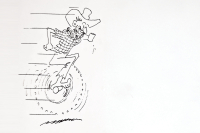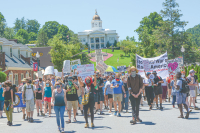Today’s writing smacks of sameness
The 1920s were a golden age for American fiction and poetry. F. Scott Fizgerald helped give the decade its name — the Jazz Age — and another writer, Thomas Wolfe, capped off the decade with his masterpiece, Look Homeward, Angel.
Between these two men other writers — Dos Passos, Hemingway, O’Neill, Faulkner, Porter, Cummings, Eliot, Frost, Sandburg, and a dozen or so other authors whose work remains in print today — began changing the face of American literature.
Following World War II — perhaps it is war that breeds such literary moments — more authors brought about a silver age in American letters. Updike, Salinger, Mailer, Styron, Jones, Baldwin, Kerouac, Capote, Miller, and many others made American writing seem exciting, not only here at home but in Europe as well.
Some authors living today — Tom Wolfe, Anne Tyler, Cormac McCarthy, and others — capture our attention, give us a sense of literary vibrancy, and yet something seems to have gone out of American writing. What passes for high literature today on the shelves of bookstores and libraries appears to the casual observer to have acquired a sort of surface similarity, a blandness, a feeling of literary white bread sameness.
Two factors may help explain this apparent homogeneity in American literature. Many writers today are graduates of Master of Fine Arts programs. They attend workshops and classes where they are encouraged in their writing. If we look at the writers prominent in the years preceding, say, the 1980s, we find that most of these writers never received a college diploma, much less attended university writing classes. Most became artists by reading extensively and by finding a mentor. Hemingway, Eliot, Faulkner: all followed this route. At this time Thomas Wolfe, who studied theater and playwriting at Harvard for two years following his graduation from Carolina, was very much the exception in terms of the formal training in his craft.
Writers today also differ from the giants who proceeded them because of our present system of grants and awards. Until quite recently, writers either made their living from their writing or found employment that allowed them to write. William Carlos Williams earned his living as a physician, delivering as many babies as he did poems. Ernest Hemingway lived off the money of his first two wives. Tennessee Williams worked a variety of odd jobs. Aline Bernstein supported Thomas Wolfe while he wrote for several years. Faulkner, Fitzgerald, and many other writers sought employment in Hollywood to allow them to continue writing their fiction.
Related Items
In other words, writers lived or died by their books. If their writing didn’t sell, they found other employment.
Today’s writers are different. Many of them are trained to write at a university. Many of them then teach in universities. Many also seek out literary grants to support them in their writing.
Browsing through the New Book shelves of the public library will quickly reveal how important grants and degrees have become to writers. In five minutes I recently found among the newly arrived books at the Pack Library thirty-four works in which the author listed at least one grant received either from an arts council, the federal or state government, or a private corporation. For review on my desk right now are two books whose authors would seem to fit the mold used today to stamp out our writers (and, I might add, our editors). Angela Pneuman, author of the short story collection Home Remedies (0-15-603705-6, $14) was a recent Stegner Fellow at Stanford University and a Presidential Fellow at SUNY Albany. In her “Acknowledgements,” she also offers thanks to the Indiana Arts Council, the Kentucky Council for the Arts, and the Headlands Center for the Arts in Marin for supporting her writing efforts. Kim Todd, author of Chrysalis: Maria Sibylla Merian and the Secrets of Metamorphosis (ISBN 0-15-101108-7, $27) has an MFA from the University of Montana. She has received several literary awards rather than grants.
On the back of Pneuman’s book is this blurb from the Z.Z. Pack: “smart, brave and unflinchingly honest.” This recommendation might mean something until we read in Pneuman’s acknowledgments that Z.Z. Pack is her “comrade and confessor.” (I first noticed this phenomenon of comrades writing blurbs for one another’s books in Charlottesville, Virginia, where the writers associated with the University of Virginia routinely touted the work of their colleagues). In both its style and its philosophy, Pneuman’s writing smacks of the classroom and the fashionable. In the final story, “The Long Game,” she gives readers insights into Priscilla, a teenager who “hates her mother” and whose father is dying of cancer. Priscilla is not a likeable character: her boyfriend Cecil calls her a “kind of a bitch,” which indeed she is. At the end of the story, when Priscilla is threatening to kill her mother with a golf club — the story ends there — I kept wishing that Priscilla would trip and her mother could deliver a good swift kick to her daughter’s pouting face.
Kim Todd gives us the story of Maria Merian, who in 1699 sailed from Amsterdam to South America to study caterpillars and metamorphosis. This was the golden age of Dutch exploration, and Todd proves an excellent guide both to Merian’s life and to the subject of metamorphosis in general. Her Prologue is a delight to read, flowing, alive with enthusiasm and passion. The text itself, however, again smacks of a classroom, of a teacher having told Todd, for example, to add immediacy by avoiding complete sentences. She writes:
There were a few more engravings to do. Type to Set. A dedication in honor of her mother, lauding her intensity, her accomplishments, one that would end, with a sigh: “her Works are now Complete.”
MFAs, grants, writing workshops, state councils for the arts: these are doubtless with us until some catastrophe — a major economic depression, a bottoming-out of the literary market — brings an end to such luxuries. Yet the work produced by these literary supports should make us pause and wonder whether the old system — publish or die — didn’t produce by its harsh code writers and publishers less inclined to such homogenous standards.
Home Remedies by Angela Pneuman. Harvest Books, 2007.
Chrysalis: Maria Sibylla Merian and the Secrets of Metamorphosis by Kim Todd. Harcourt, 2007.









